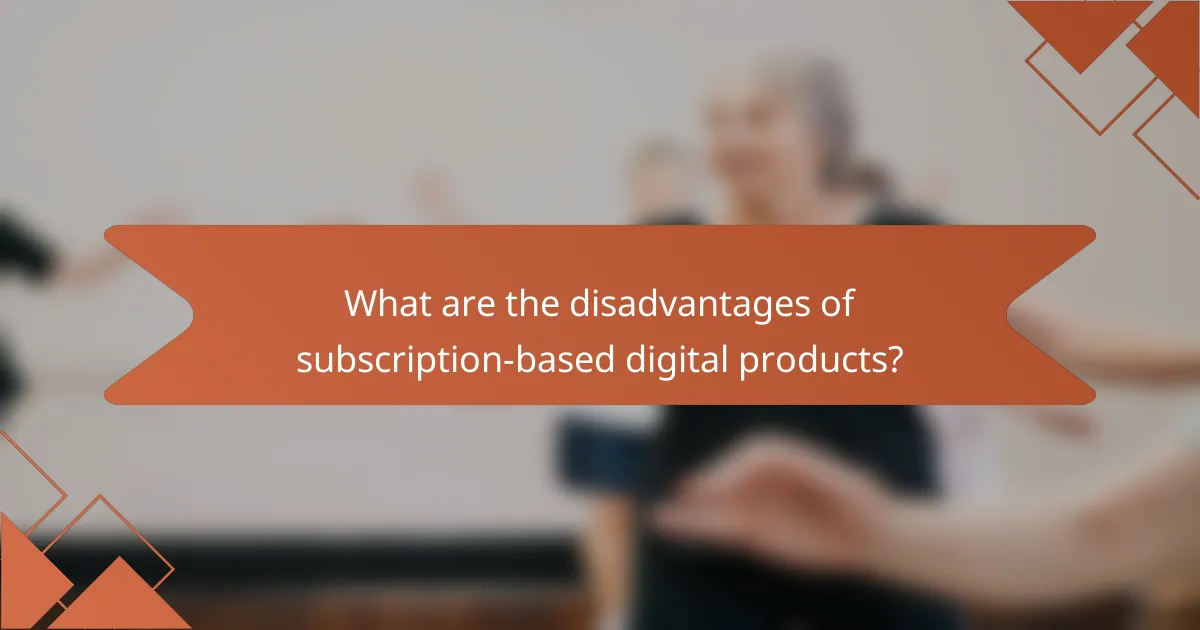Subscription-based digital products have gained popularity due to their ability to provide users with continuous access to content and services for a recurring fee. While they offer advantages such as predictable revenue for creators and lower costs for consumers, they also come with potential drawbacks like ongoing expenses and limited ownership. Understanding both the benefits and challenges of this model is essential for consumers and providers alike.

What are the advantages of subscription-based digital products?
Subscription-based digital products offer several advantages, including predictable revenue for creators and lower costs for consumers. These models foster ongoing relationships between users and providers, enhancing value through continuous access and updates.
Recurring revenue for creators
Subscription models provide a steady stream of income for creators, allowing them to plan and invest in their products more effectively. This financial stability can lead to improved quality and innovation, as creators are less reliant on one-time purchases.
For instance, a software developer might earn a consistent monthly income from subscriptions, enabling them to allocate resources toward new features or enhancements. This can lead to a better overall product for consumers.
Lower upfront costs for consumers
Consumers benefit from subscription-based products by facing lower initial costs compared to traditional one-time purchases. This makes it easier for users to access premium content or services without a significant financial commitment.
For example, instead of paying hundreds of dollars for software, a user might subscribe for a monthly fee that is a fraction of that cost. This approach lowers the barrier to entry and allows users to try products before fully committing.
Access to continuous updates
Subscription services often include regular updates and improvements, ensuring that users always have access to the latest features and security enhancements. This is particularly important in fast-evolving fields like technology and digital media.
For instance, a streaming service may regularly update its library with new content, keeping subscribers engaged and satisfied. This ongoing value can justify the subscription cost over time.
Flexible usage options
Subscription-based products typically offer flexible usage options, allowing consumers to choose plans that best fit their needs. This can include tiered pricing, which provides different levels of access based on user preferences.
For example, a cloud storage service may offer various subscription tiers based on storage capacity, enabling users to select a plan that aligns with their usage requirements. This flexibility can enhance user satisfaction and retention.
Community engagement opportunities
Many subscription-based products foster a sense of community among users, providing platforms for interaction and collaboration. This can enhance the overall experience and create loyalty among subscribers.
For instance, an online learning platform may include forums or discussion groups where subscribers can connect, share insights, and support each other. Such engagement can increase the perceived value of the subscription, encouraging long-term commitment.

What are the disadvantages of subscription-based digital products?
Subscription-based digital products come with several disadvantages that consumers should consider. These include ongoing costs, the risk of service discontinuation, content fatigue, and limited ownership of the products.
Ongoing costs for consumers
One of the main drawbacks of subscription-based digital products is the ongoing costs they impose on consumers. Unlike one-time purchases, subscriptions require regular payments, which can add up over time. For example, a monthly fee of $10 can lead to an annual expense of $120, making it essential for users to evaluate whether they are getting sufficient value.
Consumers should assess their usage patterns and determine if the subscription is worth the recurring cost. If a product is used infrequently, it may be more economical to consider alternatives that require a one-time payment.
Potential for service discontinuation
Another disadvantage is the potential for service discontinuation. Subscription services can be shut down or changed at any time, leaving users without access to previously available content. This unpredictability can be frustrating, especially for those who rely heavily on a specific service.
To mitigate this risk, consumers should diversify their subscriptions and not rely solely on one service for critical content. Keeping an eye on service reviews and company stability can also help in making informed decisions.
Content fatigue
Content fatigue can occur when users feel overwhelmed by the sheer volume of available content in subscription services. With countless options, it can be challenging to find quality material, leading to a sense of burnout. This can diminish the overall enjoyment of the service.
To combat content fatigue, users should set limits on their consumption and prioritize quality over quantity. Curating a personal list of favorite content can help streamline the experience and enhance satisfaction.
Limited ownership of products
Limited ownership is a significant concern with subscription-based digital products. Users typically do not own the content they access, which means they lose access if they cancel their subscription. This lack of ownership can be particularly problematic for digital media like movies, music, or software.
Consumers should consider whether they prefer ownership or access. For those who value long-term access, purchasing products outright may be a better option. Evaluating the terms of service and understanding what happens to content upon cancellation is crucial for informed decision-making.

How do subscription-based digital products provide value?
Subscription-based digital products deliver value by offering users continuous access to content or services for a recurring fee. This model enhances customer loyalty, ensures predictable revenue for businesses, and allows for ongoing updates and improvements.
Enhanced user experience
Subscription models often lead to a more engaging user experience by providing regular updates and new content. For example, streaming services frequently add new shows and movies, keeping users interested and encouraging them to stay subscribed.
Additionally, subscriptions can reduce the friction of one-time purchases, allowing users to explore a wider range of products without significant upfront costs. This accessibility can lead to higher satisfaction and retention rates.
Scalability for businesses
Subscription-based models enable businesses to scale efficiently by generating steady revenue streams. This predictability allows companies to invest in growth initiatives, such as expanding their offerings or enhancing technology.
Moreover, businesses can adjust their subscription tiers to cater to different customer segments, providing options that range from basic access to premium features. This flexibility can attract a broader audience and increase overall market share.
Personalization through data
Subscription services can leverage user data to create personalized experiences, tailoring content and recommendations to individual preferences. For instance, music streaming platforms analyze listening habits to suggest new artists or playlists, enhancing user engagement.
However, businesses must balance personalization with privacy concerns. Clear communication about data usage and offering opt-out options can help maintain trust while still delivering customized experiences.

What factors should be considered when choosing a subscription service?
When selecting a subscription service, it’s essential to evaluate factors such as content quality, pricing structure, and customer support. These elements significantly influence user satisfaction and overall value derived from the service.
Content quality and relevance
Content quality and relevance are critical when choosing a subscription service. High-quality content that aligns with your interests ensures you get the most out of your subscription. Look for services that regularly update their offerings and provide a diverse range of materials that cater to your preferences.
Consider reading reviews or seeking recommendations to gauge the content’s quality. Services that offer free trials can also help you assess whether their content meets your expectations before committing financially.
Pricing structure and tiers
The pricing structure and tiers of a subscription service can vary widely, impacting your decision. Many services offer multiple tiers, ranging from basic access to premium features, which can include exclusive content or additional functionalities. Assess what each tier includes and determine if the higher-priced options provide sufficient value for your needs.
Be mindful of any hidden fees or cancellation policies that may apply. Some services may offer discounts for annual subscriptions, which can be a cost-effective option if you plan to use the service long-term.
Customer support and service
Customer support and service are vital components of a positive subscription experience. A responsive support team can help resolve issues quickly, enhancing your overall satisfaction. Look for services that offer multiple support channels, such as live chat, email, or phone support, and check their availability hours.
Additionally, consider the service’s user community or forums, as these can provide valuable insights and assistance from fellow users. A strong support network can significantly improve your experience with the subscription service.

How do subscription models compare across different industries?
Subscription models vary significantly across industries, each offering unique advantages and challenges. Understanding these differences can help consumers and businesses make informed decisions about which subscription services best meet their needs.
Software as a Service (SaaS)
SaaS subscription models provide access to software applications hosted in the cloud, typically billed monthly or annually. This model allows users to avoid hefty upfront costs associated with traditional software purchases, making it financially accessible for businesses of all sizes.
Key considerations for SaaS subscriptions include the level of customer support, software updates, and scalability. Many providers offer tiered pricing based on features, which can range from basic plans for small teams to comprehensive packages for larger enterprises.
Common pitfalls include underestimating the total cost of ownership when adding multiple subscriptions or failing to evaluate the long-term commitment required. Businesses should regularly assess their usage to ensure they are not paying for unused features.
Streaming platforms
Streaming platforms operate on subscription models that allow users to access a library of content, such as movies, music, or live events, for a recurring fee. This model has transformed how consumers engage with entertainment, offering flexibility and a vast selection at their fingertips.
When considering streaming subscriptions, factors like content variety, user interface, and device compatibility are crucial. Monthly fees can vary widely, typically ranging from around $5 to $20 USD, depending on the service and content offered.
To maximize value, users should take advantage of free trials and promotional offers. Additionally, it’s wise to periodically review subscriptions to avoid accumulating services that overlap in content or features, ensuring a tailored entertainment experience.
